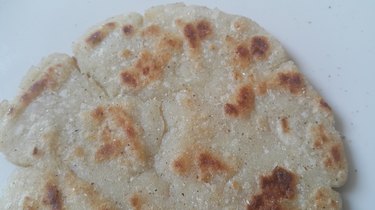
Jowar roti, a traditional Indian flatbread, is made exclusively of jowar (sorghum) flour and water. Because of those simple ingredients, jowar roti calories and its nutritional breakdown depend on the specifics of the flour you use.
Jowar Nutrition Information
Video of the Day
As Indian food and garden blogger Singari Indira explains, jowar roti is a traditional, unleavened Indian bread made of nothing but jowar flour, water — and an enormous amount of skill that's in danger of becoming a lost art. Sorghum is naturally gluten-free, and, as Indira notes, that's what makes it so challenging to work the jowar roti dough.
Video of the Day
Because the only ingredients in this flatbread are flour and water, jowar roti calories and other nutrition information depend entirely on the flour you're using. The USDA offers a nutritional breakdown for exactly one brand of jowar flour, which is produced by Deep Foods Inc.
According to the USDA, a quarter-cup of Deep Foods Inc. jowar flour contains about 117 calories. The macronutrient breakdown is 3 grams of protein, just under 1 grams of fat and 24 grams of carbohydrates in jowar flour, plus 2 grams of fiber and 2 grams of sugar. The same serving of jowar flour contains 1.8 milligrams of iron and 9.9 milligrams of sodium.
What About Sorghum?
Because jowar is sorghum (also known as guinea corn), and the nutrition information is necessarily specific to the branded product at hand, it's helpful to look at the USDA's non-branded nutrition information for sorghum flour.
According to the USDA, a quarter-cup of sorghum flour contains 108.5 calories, broken down into just over 2.5 grams of protein, just over 1 gram of fat and just over 23 grams of carbohydrate. That quarter-cup of sorghum flour also contains about 2 grams of fiber and just under 0.6 grams of sugar, along with 3.6 milligrams calcium, just less than 1 milligram iron, just under 38 milligrams of magnesium, 84 milligrams of phosphorus, 98 milligrams potassium and 0.9 milligrams sodium.
Finally, keep in mind that while roti refers to the type of flatbread, jowar is the type of grain used. So not all types of roti will be made with jowar or sorghum flour. For example, the USDA also provides nutritional information for commercial roti made with wheat. This is particularly important if you're eating gluten-free, so make sure you pay attention to what sort of grain you're getting in commercially purchased Indian flatbreads or any sort of flour intended for making roti.
What Else Are You Eating?
If you're counting calories or trying to balance your nutrient intake, don't forget to take into account the calorie and nutrition information of whatever other foods you're eating with your jowar roti. When in doubt, check the nutrition facts label. If no label is available, the USDA's FoodData Central is one of the best sources for nutrition information on a great many foods.
And, although jowar roti's ingredients are deceptively simple, its fiber content can add up fast as part of a balanced diet. Fiber doesn't cancel out the carbohydrates in your jowar roti, but it does offer numerous health benefits, including better bowel health, lower cholesterol and better control of your blood sugar levels. The Department of Health and Human Services recommends that adults consume between 22.4 and 33.6 grams of fiber per day, depending on age and gender.
- Mahanandi: "Sorghum Roti (Jonna Rotte, Jowar Roti)"
- USDA: "Jowar Flour"
- USDA: "Sorghum Flour, Whole-Grain"
- USDA: "Bread, Chappatti or Roti (Indian Bread), Wheat"
- USDA FoodData Central: "USDA FoodData Central"
- Department of Health and Human Services: "Daily Nutritional Goals for Age-Sex Groups Based on Dietary Reference Intakes and Dietary Guidelines Recommendations"
- Mayo Clinic: "Dietary Fiber: Essential for a Healthy Diet"